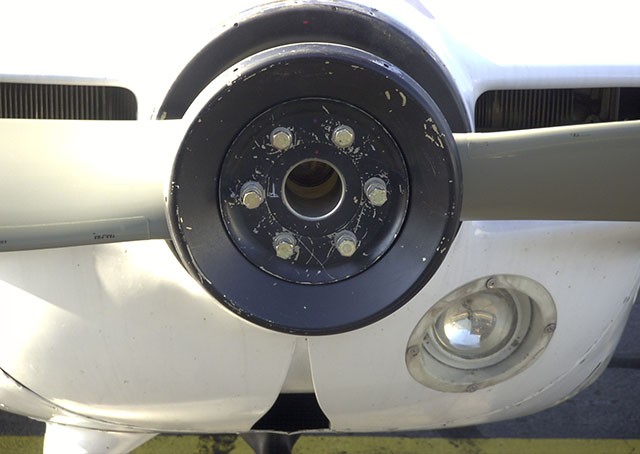Aircraft Maintenance: Parting ways with a prop
Tips to avoid maintenance-induced failures, Part 4

In this series of articles, we have been reviewing component failures and safety issues caused by well-intended maintenance tasks. Our mission is to explore a variety of cases in order to learn from the experience of others and to understand why it is so important for maintenance providers and owners alike to look at inspection and preventive maintenance situations with a more critical eye.
Case 4

In 1999, Sen. Jim Inhofe (R-Okla.), a pilot and strong supporter of general aviation, experienced an in-flight propeller failure on his way to a meeting with President Bill Clinton. He was flying his Grumman Tiger, a four-seat, 180-horsepower single-engine aircraft with a fixed-pitch propeller.
Inhofe felt a vibration en route, followed by an explosive sound as the propeller completely departed from the aircraft. His training and experience led him to act fast and shut down the engine before it oversped and caused further damage. Surprisingly, the aircraft remained controllable, in spite of the extreme aft-center-of-gravity condition. Fortunately, the loss of the prop also translated into a loss of drag, which helped him glide back to the airport and land safely.
An investigation of the failure found that the propeller had been installed incorrectly following recent maintenance. Routine maintenance such as replacing the alternator belt or starter on a Grumman requires the removal of the propeller prior to removing the nose bowl, which increases the frequency of prop removal/reinstallation—a very critical task to perform properly.
The crankshaft flange has an indexing “pin” that ensures the propeller is properly oriented—or “clocked”—on the flange during installation. The spinner back plate is sandwiched between the propeller and the crank flange, and has a corresponding hole for the pin to pass through into the prop.
 Unfortunately, it is very easy to align the spinner back plate incorrectly during the installation of the propeller, causing the pin to punch a new hole in the spinner back plate and making it appear that all is well as the propeller is torqued down. However, all is not well because the remains of the newly punched-out hole can be caught between the propeller and back plate. This situation prevents the surfaces from mating correctly and, as the trapped material wears down, the space is freed up and the prop bolts no longer hold the propeller tightly to the crankshaft flange.
Unfortunately, it is very easy to align the spinner back plate incorrectly during the installation of the propeller, causing the pin to punch a new hole in the spinner back plate and making it appear that all is well as the propeller is torqued down. However, all is not well because the remains of the newly punched-out hole can be caught between the propeller and back plate. This situation prevents the surfaces from mating correctly and, as the trapped material wears down, the space is freed up and the prop bolts no longer hold the propeller tightly to the crankshaft flange.
The scenario described above is exactly what happened in Inhofe’s case. As soon as the trapped aluminum had worn away, the resulting stress on the loose bolts caused them to shear, and the prop landed well before the aircraft did. In a strange twist of fate, one of Inhofe’s high school classmates found the propeller, resulting in a reunion of sorts for the propeller, the classmate, and the Senator back at the airport.
A supplemental type certificate exists for Grumman single-engine aircraft that splits the nose bowl so that it can be easily removed without requiring the prop to be removed—an excellent example of an aircraft modification that reduces both maintenance and the risk for maintenance-induced failures.
Grumman-savvy mechanics know to watch out for misalignment of the spinner back plate during propeller installation; mechanics without much Grumman experience must carefully follow the maintenance manuals to ensure that this seemingly straightforward task doesn’t go awry. This is just another case where attention to detail matters, even when the task seems simple.
As we continue this series, we will review more interesting cases of maintenance-induced failures. If you have your own story of “well intentioned maintenance gone wrong,” please pass it along at [email protected]. Until then, happy flying!
Interested in aircraft maintenance? View the archives of Jeff Simon’s Aircraft Maintenance series.
 Jeff Simon is an A&P mechanic, pilot, and aircraft owner. He has spent the last 14 years promoting owner-assisted aircraft maintenance as a columnist for several major aviation publications and through his how-to DVD series: The Educated Owner. Jeff is also the creator of SocialFlight, the free mobile app and website that maps over 20,000 aviation events, $100 hamburgers, and educational aviation videos. Free apps available for iPhone, iPad and Android, and on the Web at www.SocialFlight.com.
Jeff Simon is an A&P mechanic, pilot, and aircraft owner. He has spent the last 14 years promoting owner-assisted aircraft maintenance as a columnist for several major aviation publications and through his how-to DVD series: The Educated Owner. Jeff is also the creator of SocialFlight, the free mobile app and website that maps over 20,000 aviation events, $100 hamburgers, and educational aviation videos. Free apps available for iPhone, iPad and Android, and on the Web at www.SocialFlight.com.



